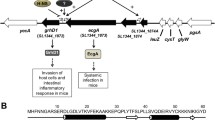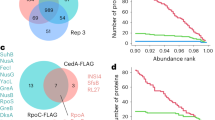Abstract
The expression of virulence factors such as hemolysin and lipopolysaccharides in Proteobacteria is regulated by the transcription elongation factor RfaH. RfaH reduces pausing and termination at intergenic sites, and thus allows RNA polymerase to conclude transcription of the distal genes in long virulence operons. The yaeQ gene of Salmonella enterica sv. Typhimurium has been identified as a high-copy-number suppressor of the hemolytic defect in an rfaH deletion strain, leading to speculation regarding a direct role of YaeQ in the transcriptional control of bacterial virulence. In order to evaluate this hypothesis, yaeQ genes from Escherichia coli and S. enterica sv. Typhimurium were cloned and expressed. Their products, purified YaeQ proteins, displayed no antitermination effects in in-vitro transcription assays over a wide range of concentrations, neither by themselves nor in competition with RfaH. When overexpressed in vivo, plasmid-borne E. coli and S. enterica sv. Typhimurium yaeQ genes also failed to restore hemolytic activity in an rfaH deletion strain under conditions in which episomal E. coli rfaH and its orthologs exhibited full complementation of the genomic rfaH deletion. Taken together, our findings do not support the hypothesis of YaeQ involvement in RfaH-dependent regulation of virulence, even in stoichiometric excess in vitro or upon overexpression in vivo.




Similar content being viewed by others
References
Artsimovitch I, Landick R (2000) Pausing by bacterial RNA polymerase is mediated by mechanistically distinct classes of signals. Proc Natl Acad Sci USA 97:7090–7095
Artsimovitch I, Landick R (2002) The transcriptional regulator RfaH stimulates RNA chain synthesis after recruitment to elongation complexes by the exposed nontemplate DNA strand. Cell 109:193–203
Artsimovitch I, Svetlov V, Murakami KS, Landick R (2003) Co-overexpression of Escherichia coli RNA polymerase subunits allows isolation and analysis of mutant enzymes lacking lineage-specific sequence insertions. J Biol Chem 278:12344–12355
Bailey MJ, Koronakis V, Schmoll T, Hughes C (1992) Escherichia coli HlyT protein, a transcriptional activator of haemolysin synthesis and secretion, is encoded by the rfaH ( sfrB) locus required for expression of sex factor and lipopolysaccharide genes. Mol Microbiol 6:1003–1012
Bailey MJ, Hughes C, Koronakis V (1996) Increased distal gene transcription by the elongation factor RfaH, a specialized homologue of NusG. Mol Microbiol 22:729–737
Bailey M, Hughes C, Koronakis V (1997) RfaH and the ops element, components of a novel system controlling bacterial transcription elongation. Mol Microbiol 26:845–851
Bailey MJ, Hughes C, Koronakis V (2000) In vitro recruitment of the RfaH regulatory protein into a specialised transcription complex, directed by the nucleic acid ops element. Mol Gen Genet 262:1052–1059
Beutin L, Manning PA, Achtman M, Willetts N (1981) sfrA and sfrB products of Escherichia coli K-12 are transcriptional control factors. J Bacteriol 145:840–844
Bittner M, Saldias S, Estevez C, Zaldivar M, Marolda CL, Valvano MA, Contreras I (2002) O-antigen expression in Salmonella enterica serovar Typhi is regulated by nitrogen availability through RpoN-mediated transcriptional control of the rfaH gene. Microbiology 148:3789–3799
Bittner M, Saldias S, Altamirano F, Valvano MA, Contreras I (2004) RpoS and RpoN are involved in the growth-dependent regulation of rfaH transcription and O antigen expression in Salmonella enterica serovar Typhi. Microb Pathog 36:19–24
Carter HD, Svetlov V, Artsimovitch I (2004) Highly divergent RfaH orthologs from pathogenic proteobacteria can substitute for Escherichia coli RfaH both in vivo and in vitro. J Bacteriol 186:2829–2840
Farewell A, Brazas R, Davie E, Mason J, Rothfield L (1991) Suppression of the abnormal phenotype of Salmonella typhimurium rfaH mutants by mutations in the gene for transcription termination factor Rho. J Bacteriol 173:5188–5193
Henikoff S, Henikoff JG, Pietrokovski S (1999) Blocks+: a non-redundant database of protein alignment blocks derived from multiple compilations. Bioinformatics 15:471–479
Jin D, Burgess R, Richardson J, Gross C (1992) Termination efficiency at rho-dependent terminators depends on kinetic coupling between RNA polymerase and Rho. Proc Natl Acad Sci USA 89:1453–1457
Koronakis V, Cross M, Hughes C (1988) Expression of the E. coli hemolysin secretion gene hlyB involves transcript anti-termination within the hly operon. Nucleic Acids Res 16:4789–4800
Koronakis V, Cross M, Hughes C (1989) Transcription antitermination in an Escherichia coli haemolysin operon is directed progressively by cis-acting DNA sequences upstream of the promoter region. Mol Microbiol 3:1397–1404
Landick R, Wang D, Chan C (1996) Quantitative analysis of transcriptional pausing by RNA polymerase: the his leader pause site as a paradigm. Methods Enzymol 274:334–352
Leeds J, Welch R (1996) RfaH enhances elongation of Escherichia coli hlyCABD mRNA. J Bacteriol 178:1850–1857
Leeds J, Welch R (1997) Enhancing transcription through the Escherichia coli hemolysin operon, hlyCABD: RfaH and upstream JUMPStart DNA sequences function together via a postinitiation mechanism. J Bacteriol 179:3519–3527
McDowell JC, Roberts JW, Jin DJ, Gross C (1994) Determination of intrinsic transcription termination efficiency by RNA polymerase elongation rate. Science 266:822–825
Nagy G, Dobrindt U, Kupfer M, Emody L, Karch H, Hacker J (2001) Expression of hemin receptor molecule ChuA is influenced by RfaH in uropathogenic Escherichia coli strain 536. Infect Immun 69:1924–1928
Nagy G, Dobrindt U, Schneider G, Khan AS, Hacker J, Emody L (2002) Loss of regulatory protein RfaH attenuates virulence of uropathogenic Escherichia coli. Infect Immun 70:4406–4413
Nieto JM, Bailey MJ, Hughes C, Koronakis V (1996) Suppression of transcription polarity in the Escherichia coli haemolysin operon by a short upstream element shared by polysaccharide and DNA transfer determinants. Mol Microbiol 19:705–713
Paitan Y, Orr E, Ron E, Rosenberg E (1999) A NusG-like transcription anti-terminator is involved in the biosynthesis of the polyketide antibiotic TA of Myxococcus xanthus. FEMS Microbiol Lett 170:221–227
Rojas G, Saldias S, Bittner M, Zaldivar M, Contreras I (2001) The rfaH gene, which affects lipopolysaccharide synthesis in Salmonella enterica serovar Typhi, is differentially expressed during the bacterial growth phase. FEMS Microbiol Lett 204:123–128
Stevens M, Clarke B, Roberts I (1997) Regulation of the Escherichia coli K5 capsule gene cluster by transcription antitermination. Mol Microbiol 24:1001–1012
Wandersman C, Letoffe S (1993) Involvement of lipopolysaccharide in the secretion of Escherichia coli alpha-haemolysin and Erwinia chrysanthemi proteases. Mol Microbiol 7:141–150
Weisberg RA, Gottesman ME (1999) Processive antitermination. J Bacteriol 181:359–367
Welch RA, Pellett S (1988) Transcriptional organization of the Escherichia coli hemolysin genes. J Bacteriol 170:1622–1630
Wong KR, Hughes C, Koronakis V (1998) A gene, yaeQ , that suppresses reduced operon expression caused by mutations in the transcription elongation gene rfaH in Escherichia coli and Salmonella typhimurium. Mol Gen Genet 257:693–696
Acknowledgements
This work was supported by grants from National Institutes of Health and American Heart Association. We thank Vladimir Svetlov for fruitful discussions and for suggestions during the manuscript preparation
Author information
Authors and Affiliations
Corresponding author
Additional information
Communicated by C. P. Hollenberg
Rights and permissions
About this article
Cite this article
Vicari, D., Artsimovitch, I. Virulence regulators RfaH and YaeQ do not operate in the same pathway. Mol Genet Genomics 272, 489–496 (2004). https://doi.org/10.1007/s00438-004-1065-x
Received:
Accepted:
Published:
Issue Date:
DOI: https://doi.org/10.1007/s00438-004-1065-x




